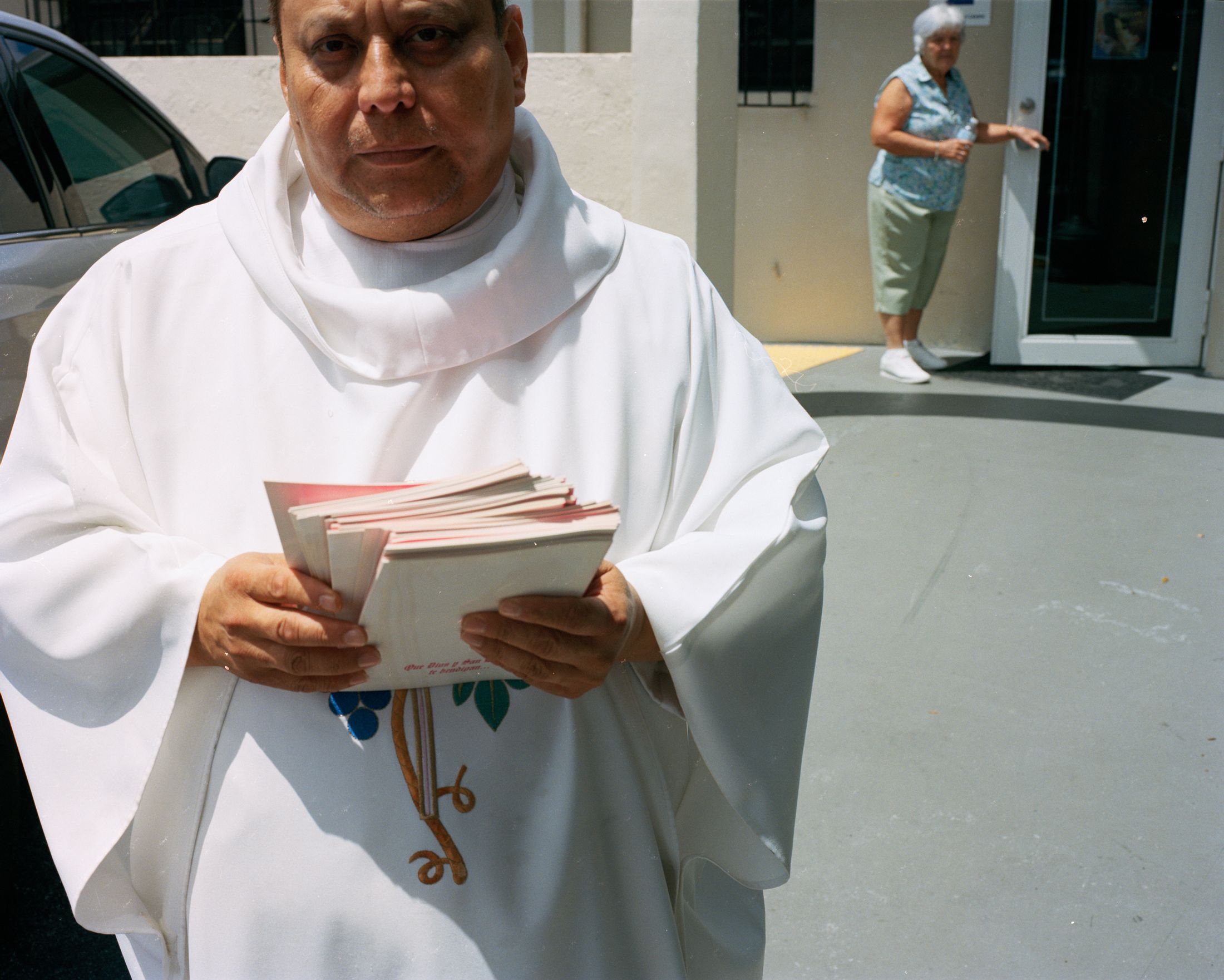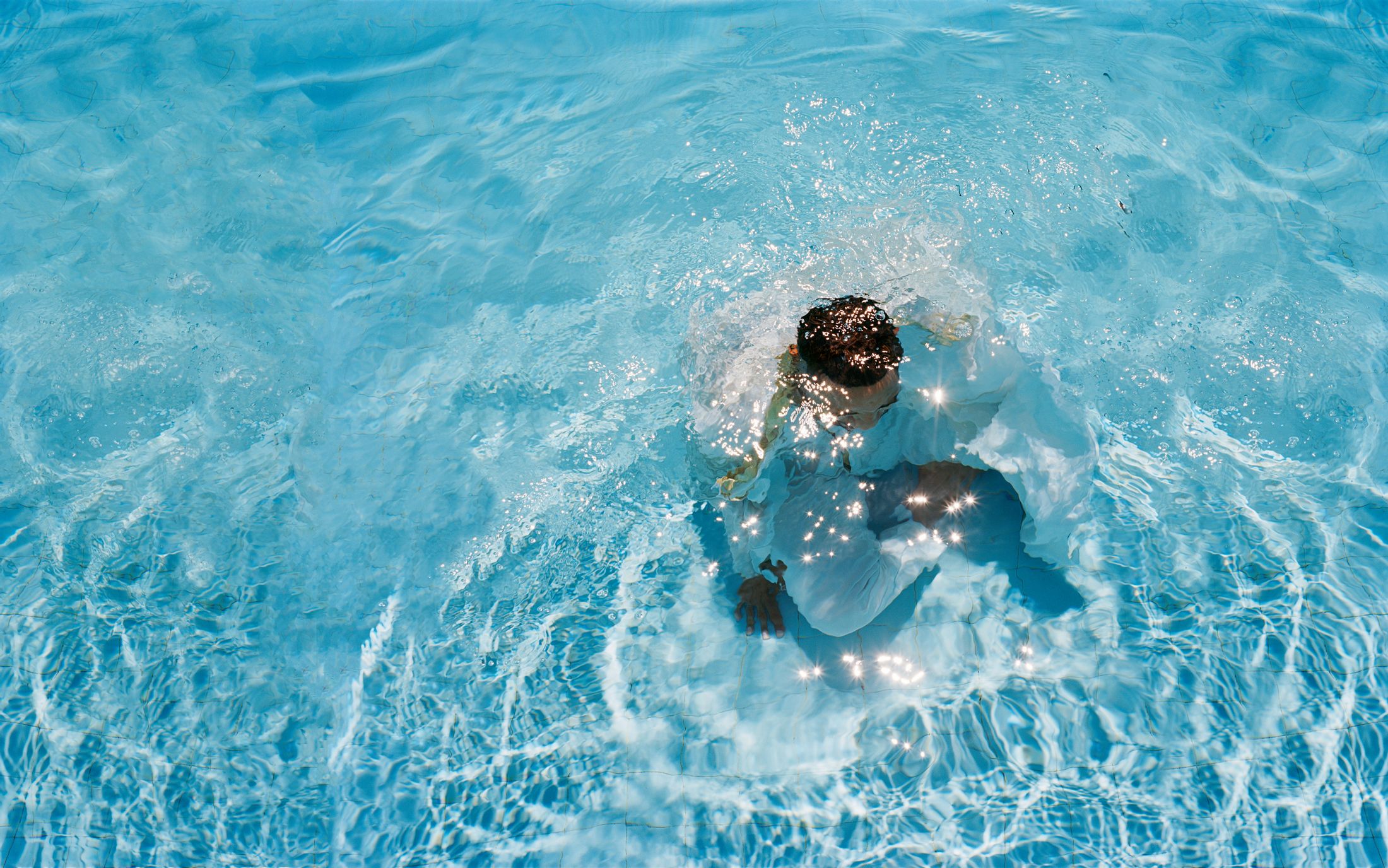A More Fluid Atmosphere
Pomegranate Press
Book
Miami, Florida
2017-ongoing
Info
A More Fluid Atmosphere
Pomegranate Press
Book
Miami, Florida
2017-ongoing
Everything gleams in Miami: car parts doused in copper paint, blood spilling down a skinned knee, gold dust slipping through anonymous hands. Part Global North, part Southern tropical metropolis, the city appears bright and sometimes garish in the series “A More Fluid Atmosphere.” Hovering between visual metaphor and documentation, the photographs in this ongoing project represent a city known for its glitzy excess, its coastlands imperiled by imminent rising tides, and its deep-seated cultural syncretism of Latin American and Caribbean cultures. But they don’t deal in recognizable specificity. Characteristic of Cromwell’s subtly surreal approach to capturing places that exist at-the-juncture-of, these photographs describe an ineffable space in the middle, sometimes unremarkable and invisible to many: the bucket of roses in someone’s hand; hand-lettered signs advertising new tires; fridges for sale lined up on the sidewalk, as if following instructions. Things in the middle can also shine.
Writer Joan Didion described the weightlessness she experienced whenever she boarded a flight to Miami, how it manifested as “the heightened wariness of having left the developed world for a more fluid atmosphere.” Cromwell’s photographs suggest that the forces governing this flowing realm ripple under the surface. Water is portioned into small bottles. Jet skis are stranded on land. Palm fronds appear in chaos—the product of hurricanes, or other tempests? The sway of organized religion is conveyed in the blinding whiteness of a priest’s starched robes. This is a society of constructions and automobiles, of progress and capitalism unfettered even in the face of rising tides. Meanwhile, a cat looks disapprovingly from its window perch; a dog growls behind the fence; and two ducks stand calmly in the sun’s long beam, careful to avoid the shadow cast by a car. In this version of Miami, it’s the animals that exert the most grounding force.
.
Paula Kupfer
Writer Joan Didion described the weightlessness she experienced whenever she boarded a flight to Miami, how it manifested as “the heightened wariness of having left the developed world for a more fluid atmosphere.” Cromwell’s photographs suggest that the forces governing this flowing realm ripple under the surface. Water is portioned into small bottles. Jet skis are stranded on land. Palm fronds appear in chaos—the product of hurricanes, or other tempests? The sway of organized religion is conveyed in the blinding whiteness of a priest’s starched robes. This is a society of constructions and automobiles, of progress and capitalism unfettered even in the face of rising tides. Meanwhile, a cat looks disapprovingly from its window perch; a dog growls behind the fence; and two ducks stand calmly in the sun’s long beam, careful to avoid the shadow cast by a car. In this version of Miami, it’s the animals that exert the most grounding force.
.
Paula Kupfer
Everything gleams in Miami: car parts doused in copper paint, blood spilling down a skinned knee, gold dust slipping through anonymous hands. Part Global North, part Southern tropical metropolis, the city appears bright and sometimes garish in the series “A More Fluid Atmosphere.” Hovering between visual metaphor and documentation, the photographs in this ongoing project represent a city known for its glitzy excess, its coastlands imperiled by imminent rising tides, and its deep-seated cultural syncretism of Latin American and Caribbean cultures. But they don’t deal in recognizable specificity. Characteristic of Cromwell’s subtly surreal approach to capturing places that exist at-the-juncture-of, these photographs describe an ineffable space in the middle, sometimes unremarkable and invisible to many: the bucket of roses in someone’s hand; hand-lettered signs advertising new tires; fridges for sale lined up on the sidewalk, as if following instructions. Things in the middle can also shine.
Writer Joan Didion described the weightlessness she experienced whenever she boarded a flight to Miami, how it manifested as “the heightened wariness of having left the developed world for a more fluid atmosphere.” Cromwell’s photographs suggest that the forces governing this flowing realm ripple under the surface. Water is portioned into small bottles. Jet skis are stranded on land. Palm fronds appear in chaos—the product of hurricanes, or other tempests? The sway of organized religion is conveyed in the blinding whiteness of a priest’s starched robes. This is a society of constructions and automobiles, of progress and capitalism unfettered even in the face of rising tides. Meanwhile, a cat looks disapprovingly from its window perch; a dog growls behind the fence; and two ducks stand calmly in the sun’s long beam, careful to avoid the shadow cast by a car. In this version of Miami, it’s the animals that exert the most grounding force.
Writer Joan Didion described the weightlessness she experienced whenever she boarded a flight to Miami, how it manifested as “the heightened wariness of having left the developed world for a more fluid atmosphere.” Cromwell’s photographs suggest that the forces governing this flowing realm ripple under the surface. Water is portioned into small bottles. Jet skis are stranded on land. Palm fronds appear in chaos—the product of hurricanes, or other tempests? The sway of organized religion is conveyed in the blinding whiteness of a priest’s starched robes. This is a society of constructions and automobiles, of progress and capitalism unfettered even in the face of rising tides. Meanwhile, a cat looks disapprovingly from its window perch; a dog growls behind the fence; and two ducks stand calmly in the sun’s long beam, careful to avoid the shadow cast by a car. In this version of Miami, it’s the animals that exert the most grounding force.
Continue Reading
Paula Kupfer




RELATED CONTENT







